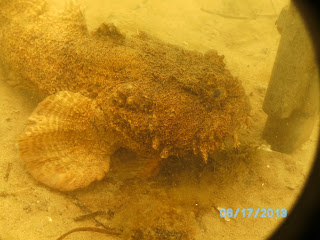This week I enjoyed a breathtaking flight over Buzzards Bay thanks to a LightHawk donated flight http://lighthawk.org/ flown
by pilot David Murphy. I was focused on West Falmouth Harbor to take aerial photos of the impact of boat moorings on seagrass meadows, as part of a project funded by the Atlantic Coastal Fish Habitat Partnership. The photos below show the striking mooring
scars in the eelgrass bed. Propeller and rudder scars are also
evident.
MarineFisheries
received a grant in 2012 from the Atlantic Coastal Fish Habitat Partnership to continue studying the
impact of conventional moorings (anchor and chain) on seagrass meadows, and to test the utility of a new innovative mooring design referred to here as a
"conservation mooring". Previously, we tested conservation moorings installed in Manchester-by-the-Sea and we continue to monitor the mooring scars and measure changes at that location. The new funding enables us to expand the project to a harbor on the Cape and test the concept in a different system.
Conventional moorings have heavy chain that drags along the bottom, stirring up sediment and ripping out seagrass. Conservation
moorings use floating, flexible line that does not contact the bottom and a helical anchor driven into the sediment for maximum holding power with minimal footprint. These systems may minimize scouring
of the seafloor and reduce impacts to seagrass and water quality.
 |
| A) Conventional Mooring with chain drag; B) Conservation mooring and eelgrass |
 |
| Left: helical anchor; Middle: Hazelett flex rode; Right: Ecomoorings flex rode |
 |
| Dave Merrill installing a helix mooring anchor in W. Falmouth |
With grant funding, 8 conventional moorings were voluntarily
converted at no cost to the owner, to a conservation mooring. Such
conservation moorings have been in use locally for several years already in Marion, Chatham, Tisbury (Vineyard
Haven), and Lake Tashmoo, with good reviews from boat owners and harbormasters.
There are several designs and brands of conservation mooring. Eco-Mooring by BoatMoorings.com,
a New England based company, and Hazelett Systems, were chosen for comparison in
West Falmouth Harbor. Dave Merrill of BoatMoorings.com worked together with the local mooring maintainers in West Falmouth to install all 8 moorings in May 2013.
These photos will be our "before" conditions. Stay tuned in the coming years to see how this seagrass meadow changes.
























